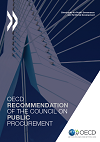Public Procurement Reform in the Slovak Republic
Support for the implementation of the Slovak public procurement reform in the framework of the European Structural and Investment Funds ex-ante conditionality action plan
Public procurement accounts for 13.2% of the Slovak Republic’s GDP and represents more than 32% of the total government expenditure, both figures being slightly above the OECD average. Public procurement in the Slovak Republic is not only financed by the government budget but also significantly draws on European resources. Indeed, the main European investment tool – the 2014-2020 European Structural and Investment Funds – finances more than 90% of the total public investment in the Slovak Republic, the highest percentage across Europe.
Yet, to continue benefiting from this financing source, the country has to adapt, under challenging deadlines, its national procurement framework and practices to meet the ex-ante conditionalities defined in the Art. 19 of the EU Regulation No 1303/2013, the Common Provision Regulation. To meet those ex-ante conditionalities several reforms of the public procurement system and of procurement practice are needed.
To reap the benefits of the implementation of strategic public procurement, the Slovak authorities and the European Commission called upon the OECD to assist in the implementation of an environment conducive to procurement performance, notably by:
- Implementing a comprehensive e-Procurement strategy.
- Defining a training action plan to reinforce the capacity of the procurement workforce
- Evaluating the effectiveness of the existing ex-ante control mechanisms.
Fast Facts
 |
Country: Slovak Republic |
 |
Timeframe: March 2016 – February 2017 |
 |
Counterparts:
|
 |
Areas of focus: |
List of Deliverables
- E-procurement strategy with a clear and sustainable governance model and providing a roadmap towards transition to end-to-end e-procurement and implementation of the once-only principle
- Training action plan, definition of a training portfolio and development of training materials
- Assessment of the effectiveness of the existing ex-ante control mechanisms which are aiming to safeguard procurement processes and prevent future financial corrections
Timeline
- 2-3 March 2016: 1st Meeting of the Steering Committee
- 14 November 2016: Presentation of the draft e-procurement strategy at the ITAPA conference
- 12-14 December 2016: Workshops on secondary policy objectives and conflict of interests
- 1-2 February: Workshops on technical specifications and MEAT criteria
- 23 February 2017: Seminar on assessment of ex-ante control mechanisms and closing session of the Steering Committee
Content of the project
The Project supports the enactment of the Slovak Action Plan to satisfy the ex-ante conditionality on public procurement for ESIF. Throughout preparation and implementation of the Project, the OECD worked closely with the Slovak Republic to ensure complementarity with ongoing efforts supported by ESIF.
The work carried out by the OECD consisted in providing operational support to Slovak authorities. The Project was comprised of 3 components as follows:
Component 1 - Development and implementation of a national e-Procurement strategy.
This component, with the highest priority in terms of content and timing, consisted in providing support to define a comprehensive e-procurement strategy, including a governance model, policy ownership, systems interoperability, roadmap towards end-to-end e-procurement and implementation of the once-only principle. This component is directly connected with the first criterion of the ex-Ante Conditionality (Arrangements for the effective application of Union public procurement rules through appropriate mechanisms – action Electronic public procurement).
Component 2 - Evaluation of training needs and definition of training priorities
a. Identification of the training needs focusing on the following topics:
- most economically advantageous tender (MEAT) - best examples of social and quality awarding criteria;
- technical specification drafting - how to eliminate errors, best examples of preliminary market consultations;
- innovative, green and social public procurement;
- conflicts of interest in public procurement.
b. Definition of training priorities and development of a training portfolio for Slovak public procurement trainers in order to improve the quality of trainings, which included providing practical advice on best practice in other member States and OECD countries.
Component 3 - Assessment of the effectiveness and impact of the existing ex-ante control system
This component consisted of assessing the effectiveness and impact of the existing ex-ante control system and available methodological framework
Outputs and resources
E-PROCUREMENT
E-procurement is defined as the use of information and communications technologies in public procurement. it not only increases efficiency by facilitating access to public tenders but also imrpvoes transparency by holding public authorities more accountable. It can support the development of performance assessments using procurement information.
CAPACITY
Effective implementation of procurement reforms and specific procurement practices requires a properly trained public procurement workforce. It not only promotes the effectiveness of the system, but also its integrity. The public procurement workforce is one of the key pillars of a procurement system.
ACCOUNTABILITY
Public procurement is an activity particularly vulnerable to fraud and corruption. Oversight and control mechanisms help to support accountability throughout the public procurement process. These mechanisms encompass not only control and audit (regulatory compliance, quality performance, cost reduction, sustainability), but also review systems of procurement decisions.






